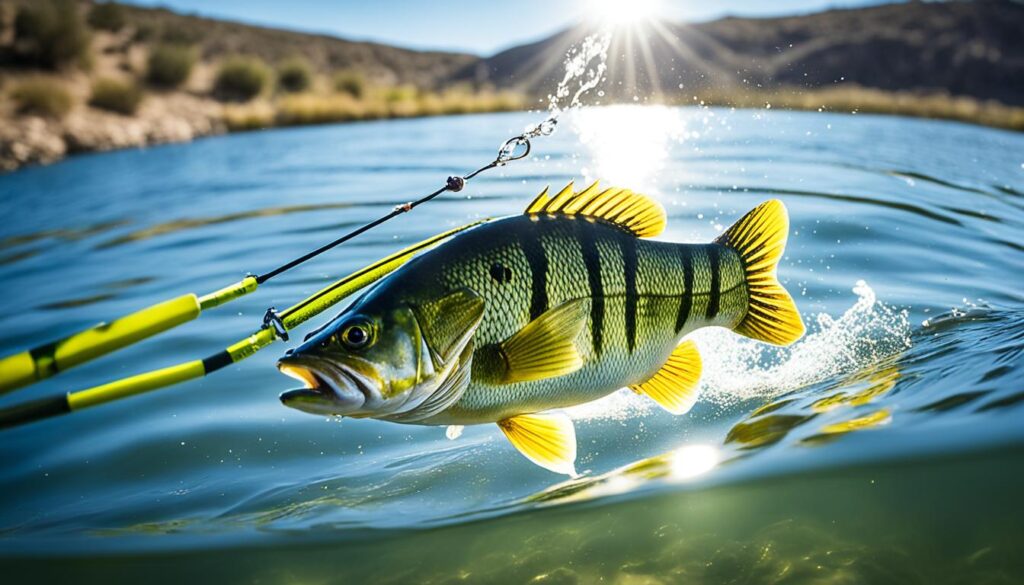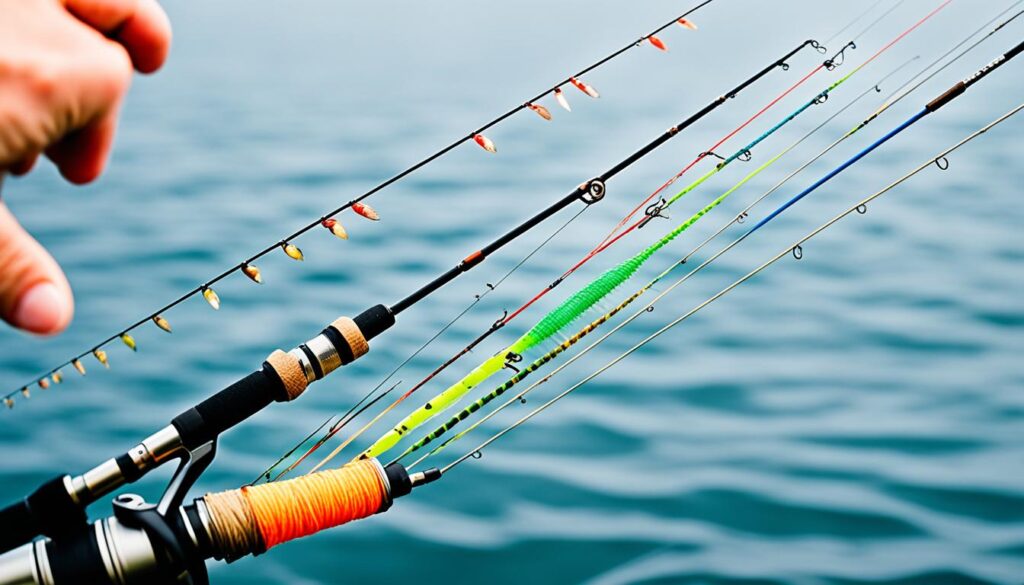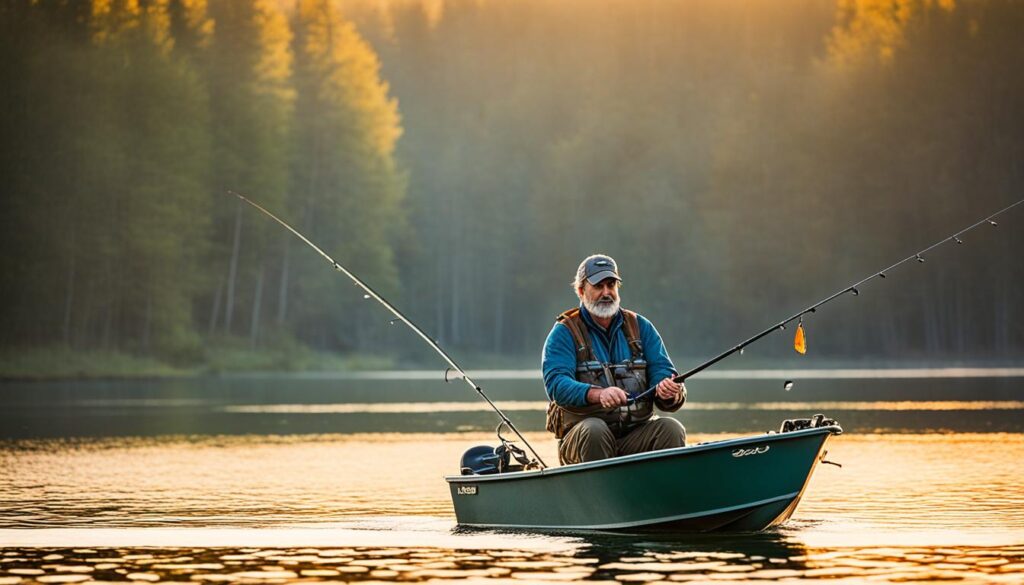Welcome to this detailed guide on a popular bass fishing method called the shaky shot. It’s perfect for bass anglers wanting to improve. The shaky shot technique uses a shaky head instead of a regular weight on a drop shot. This lets you aim for bass at various depths. It’s best for fishing near cover like brush, trees, and docks. These spots help you catch those hard-to-find bass.
The shaky shot technique works by attaching a shaky head to a Trilene knot with a longer leader. This setup makes your bait more appealing to bass hiding below. It fits various fishing situations. You can change the line thickness, shaky head weight, and bait type. For anglers in lakes where bass chase herring or threadfin shad, the shaky shot is a great choice.
Key Takeaways:
- Shaky shot is a versatile technique for targeting bass staging at different levels.
- It’s most effective when fishing around cover like brush piles, standing timber, and dock poles.
- Use a longer leader with a Trilene knot to rig the shaky head for optimum results.
- Line size, shaky head weight, and bait selection can be adjusted based on fishing conditions.
- Shaky shot is particularly effective in lakes with spotted bass targeting herring or threadfin shad.
The Basic Idea of Shaky Shot Fishing
The shaky shot method is a twist on the drop shot rig. Instead of a drop shot weight, it uses a shaky head. This setup helps fishers aim at fish at various depths.
The shaky shot stands out because of its shaky head. This head shakes or wobbles when moved, catching the attention of picky bass.
It’s key to know the rules about rigs with more than one bait. Different places have different rules on how many baits you can use on one line. So, make sure you’re following the law.
While the shaky shot might not work as well in open water, it shines near cover like brush piles and docks. The shaky head’s motion can make bass leave their spots and strike.
“The shaky shot is my go-to when fishing near lots of cover. With the shaky head, I can place my bait exactly where the fish are, without snagging. It’s a total game-changer!” – Adam, an eager bass fisher
Why Shaky Shot Works for Bass Fishing
The shaky shot works well because it taps into bass’s natural instincts. Bass are curious creatures that can’t resist erratic movement. The shaky shot acts like an injured prey, making bass more likely to bite.
| Pros | Cons |
|---|---|
| Effective for targeting fish at different depths | Less effective in open water |
| Great when fishing near cover | Needs more skill and finesse |
| The head’s movement draws bass from hiding | May be limited by local and state rules |
When to Use the Shaky Shot Technique
The shaky shot technique works well in many fishing situations. Knowing when to use it can really up your fishing game. You’ll catch more fish and have better luck on the water.
Fishing Around Cover
One of the top times to use the shaky shot is near cover. This could be brush piles, cane, timber, or dock poles. The shaky shot helps you reach fish hiding at different depths. Its light movements lure bass out, leading to more bites.
Targeting Spotted Bass
Lakes full of spotted bass chasing herring or threadfin shad are perfect for the shaky shot. These waters have lots of baitfish, making your lure more tempting. With the shaky shot, you present the bait on two levels, doubling your chances of a strike.
Fishing in Open Water
The shaky shot shines in open water too, especially if fish feed lower down. When bass hunt in open waters, they often go for bait that looks hurt. By using the shaky shot near the bottom, you appeal to their hunting instincts and get more bites.
To really make the shaky shot work, you need to get fish behavior and preferences. Pick the right time and place, and you might just catch a big one.
How to Rig the Shaky Shot
Rigging the shaky shot is simple and quick. It gets you ready for fishing fast. Just follow these easy steps for a good setup:
- Selecting the Shaky Head: First, pick a shaky head that fits your fishing situation. Most anglers go for a 1/4-ounce size. It helps in placing bait well and controlling it better.
- Tying the Trilene Knot: Use a Trilene knot to attach your bait to the shaky head. This knot is strong and keeps your bait secured, especially during big catches.
- Leaving a Longer Leader: With the Trilene knot, it’s best to leave a longer leader. This makes your bait move more naturally. The right leader length depends on how the fish are spread out in the water.
Using Electronics to Determine the Ideal Distance
Use your fishfinder to know how far away the fish are. This helps to adjust your leader length so your bait is just where the fish want it.
Experimenting with Bait Selection
Try different colors and types of worms or baits. Bass can be picky, so changing up your options can help.
You’ll be all set to fish for bass with your shaky shot rig. You’ll do it with accuracy and feel confident while doing it.
Summary: How to Rig the Shaky Shot
| Steps | Details |
|---|---|
| Selecting the Shaky Head | Choose a 1/4-ounce shaky head |
| Tying the Trilene Knot | Tie a Trilene knot to secure the bait |
| Leaving a Longer Leader | Leave a longer leader for natural bait movement |
The Different Techniques of Shaky Shot Fishing

Fishing with the shaky shot offers various techniques to catch more fish. Each method can be effective in different situations. By adjusting to the conditions, you can catch more bass.
Dragging the Shaky Head
Dragging the shaky head along the bottom is a great technique. It works well when fish gather on secondary points. Slowly pulling the shaky head can make bass near structures bite.
This method is most effective when imitating natural prey movements. Layer your bait presentation to increase success.
Hopping the Shaky Head
Twitching the shaky head upward can make bass strike. It mimics prey trying to escape. This sudden move makes bass react and bite.
It’s a good technique if you find active fish. These fish are ready to chase their prey.
Shaking the Shaky Head
Shaking the shaky head on the bottom is also effective. It makes bass want to attack. The bait’s vibrations act like an injured prey.
This method grabs the attention of bass. It’s great for catching less active fish.
Swimming the Shaky Head
Swimming the shaky head works well in shallow waters. Slowly reeling in the bait mimics a swimming baitfish. This can lead to aggressive strikes from bass.
This method is very effective in clear water. Bass can easily see and chase the bait.
Try these different shaky shot fishing techniques to improve your success. Pay attention to how fish react to find the best method.
| Technique | Advantages |
|---|---|
| Dragging the Shaky Head | Effective for fish staging on secondary points |
| Hopping the Shaky Head | Triggers reaction strikes from active fish |
| Shaking the Shaky Head | Stimulates bass’ natural instincts to attack |
| Swimming the Shaky Head | Attracts bass in shallow water searching for prey |
The Importance of Proper Gear for Shaky Shot Fishing
Using the right gear in shaky shot fishing is super important. It helps you do the technique right and catch more bass. Here’s what you need to think about for the best gear:
1. Drop Shot Hooks
It’s key to use special drop shot hooks. Choose light wire hooks like finesse or finesse wide gap. They’re strong yet sensitive, making your bait look more tempting and helping you hook fish easier.
2. Drop Shot Weights
Drop shot weights are a big deal for this fishing style. They come in many sizes so you can fish at different depths. Start with small weights and add more if you need to. This helps you stay in touch with the bottom and interesting to the fish.
3. Drop Shot Rod and Reel
Getting a specific drop shot rod and reel is a game-changer. Look for a rod that’s 6’10” to 7’2″ long, with medium-light to medium power and a fast tip. This setup lets you feel the bites and cast precisely. Pick a spinning reel, size 3000-3500, for the perfect line capacity and smooth drag.
4. Line Choice
Choosing the best line really matters in shaky shot fishing. You can go with braid to a leader or just use fluorocarbon. Braid is great for feeling the fish and lasts longer, while fluorocarbon is hard for fish to see. Pick line sizes from 10-20lb for braid and 6-12lb for fluorocarbon, based on where you’re fishing and what fish you’re after.
Having the right hooks, weights, rod and reel, and line sets you up for success in shaky shot fishing. Make sure to tweak your gear for where you’re fishing. Next, we’ll explore why picking the right line is super important in shaky shot fishing.
The Importance of Line Choice for Shaky Shot Fishing

Choosing the right line is essential for shaky shot fishing success. We have two main line options: braid to leader and straight fluorocarbon. Each has its unique benefits to improve your fishing trips.
Braid to Leader:
Braid is known for its sensitivity and resistance to wear. It comes in sizes from 10-20lb, offering the perfect strength for any situation. Its strong nature helps you feel even the slightest bites and ensures solid hook sets. This means you’ll catch more fish. Braid’s durability lets you move through obstacles without breaking the line easily.
Straight Fluorocarbon:
Fluorocarbon’s best feature is its invisibility underwater. It’s perfect for catching cautious bass. You can choose from 12lb to 6lb sizes, allowing you to adjust based on where you’re fishing. Fluorocarbon has less stretch, offering better feel for nibbles.
The leader’s length matters too when using braid. A 15-20ft leader makes bait move more naturally, like real prey. This can help you attract more bites from careful fish.
Whether you choose braid to leader or straight fluorocarbon depends on your preferences and the fishing situation. Both are excellent for shaky shot fishing. Try them out to see which works best for you and your target fish.
| Line Type | Advantages |
|---|---|
| Braid to Leader | Excellent sensitivity and abrasion resistance |
| Straight Fluorocarbon | Invisibility in the water, ideal for cautious bass |
Additional Tips and Techniques for Shaky Shot Fishing
To get better at shaky shot fishing, you need the right gear, rigging methods, and knowledge of special tricks. Learning advanced drop shot tricks, finesse fishing, and using JDM tackle can really help. These can put you ahead of other fishers and boost your chances of catching more.
Advanced Drop Shot Tricks
Taking your shaky shot fishing up a notch involves learning advanced drop shot tricks. Experiment with how you present bait and change how you retrieve it to get more bites. For instance, you can twitch the bait up or drag it on the bottom to act like real prey.
These small changes can really help attract bass.
Finesse Fishing Techniques
Finesse fishing is key for shaky shot fishing. Choose light lines and smaller baits that look like the bass’s usual food. Be slow and careful, making sure to present the bait very gently.
This method works great for getting attention from cautious bass.
Using JDM Tackle
When picking tackle, think about using JDM (Japanese Domestic Market) gear. JDM tackle stands out for its high quality, innovative design, and great performance. With special rods, reels, baits, and accessories, JDM gear can really up your shaky shot fishing game. Look into JDM gear to make your fishing better.
Adding these tips to your shaky shot fishing can really sharpen your skills and help you catch more fish. Don’t forget to try new things, adapt to the fishing spot, and always be ready to learn and try different methods.
When to Reach for the Shaky Shot and When to Opt for Another Technique
Choosing when to use the shaky shot or another technique is key for bass fishing success. The shaky shot works well when fish are at different depths or near cover. It’s also great in open water when the fish are looking for food. But, sometimes, you might find a straight drop shot or another rig fits better.
Analyzing fishing conditions helps pick the best technique. Look at the water’s clarity, type of cover, and how fish are behaving. If the water is clear and fish are feeding near the bottom, try the shaky shot. It presents the bait in a way that looks real and gets fish to bite.
If fish are in the middle of the water or you’re dealing with heavy cover, consider a straight drop shot rig. This setup lets you adjust bait depth more easily. It’s good for reaching fish that stay at certain depths.
Staying flexible and changing techniques when needed is important. Experimenting helps you find what works best in various situations. By understanding the conditions and selecting the right technique, you’re more likely to catch more fish.
Conclusion
Shaky shot fishing is a top-notch way to catch bass. It needs the right gear, rigging ways, and fishing plans. You’ll hook more bass by doing this. The shaky shot lets you aim precisely at fish at different depths. It’s good for areas with lots of covers and open waters.
Want to get better at shaky shot fishing? Try advanced drop shot tips and new methods. These can make your fishing trips better and you’ll catch more bass. Look at the fishing spot and pick the best method for that place.
Practice makes perfect with the shaky shot fishing method. Keep fishing, enjoy catching fish, and get better over time. Have fun fishing!
FAQ
What is the shaky shot technique?
The shaky shot technique is a way to catch bass by using a special setup. You attach a shaky head instead of a normal weight to a drop shot. This method is great for fishing near brush piles, timber, and docks. It helps you catch fish hiding at various depths.
When is the shaky shot technique most effective?
This technique shines when fishing near structures like brush piles and docks, or in open water. It’s especially good in lakes where spotted bass chase after herring or shad. The shaky shot works well in these situations.
How do I rig the shaky shot?
Start by tying a Trilene knot to the shaky head and leave a long leader. The leader’s length changes based on how the fish are spread out. Use your fish finder to adjust. You can switch up the shaky head weight and the bait as needed.
What are the different techniques of shaky shot fishing?
When using the shaky shot, you can drag, hop, shake, or swim the head on the bottom. Each way works best under different conditions. Try them out to see what brings the best results.
What gear is needed for shaky shot fishing?
You’ll need a drop shot hook, rod, spinning reel, and line for shaky shot fishing. Go for a finesse hook and a rod with a fast tip. Use a spinning reel, size 3000-3500. You can choose between braid with a leader or just fluorocarbon line.
What is the importance of line choice for shaky shot fishing?
The line you pick is key for shaky shot fishing. Using braid with a leader offers sensitivity and strength. Fluorocarbon, though, is almost invisible underwater. With braid setups, a longer leader can make your bait look more natural.
Are there any additional tips and techniques for shaky shot fishing?
Indeed, there are extra tips to up your shaky shot game. Learn more drop shot tricks and finesse tactics. Trying out various baits can also help. For top gear, consider getting Japanese Domestic Market (JDM) tackle.
When should I reach for the shaky shot and when should I opt for another technique?
Knowing when to use the shaky shot is crucial. It’s great for targeting fish around structures. Yet, sometimes, a different approach like a straight drop shot might work better. Assess the conditions to pick the right method.
Can you provide a summary of shaky shot fishing?
Shaky shot fishing is an effective way to catch bass. With the right equipment, setup, and tactics, you can catch more fish. It’s perfect for fishing near structures and in various water conditions. Trying different techniques can also improve your chances.
